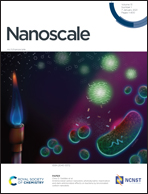Defect-assisted electronic metal–support interactions: tuning the interplay between Ru nanoparticles and CuO supports for pH-neutral oxygen evolution†
Abstract
Electronic metal–support interactions (EMSIs) comprise an area of intense study, the manipulation of which is of paramount importance in the improvement of heterogeneous metal nanoparticle (NP) supported catalysts. EMSI is the transfer of charge from the support to NP, enabling more effective adsorption and interaction of reactants during catalysis. Ru NPs on CuO supports show different levels of EMSI (via charge transfer) depending on their crystal structure, with multiple twinned NPs showing greater potential for EMSI. We use magnetron-assisted gas phase aggregation for the synthesis of batches of Ru NPs with different populations of single crystal and multiple twinned nanoparticles, which were deposited on CuO nanowires (NWs). The surface charging of the Ru-CuO catalysts was investigated by Kelvin probe force microscopy (KPFM) and X-ray photoelectron spectroscopy (XPS). By doubling the population of multiple twinned NPs, the surface potential of the Ru-CuO catalysts increases roughly 4 times, coinciding with a similar increase in the amount of Ru4+. Therefore, tuning the amount of EMSI in a catalyst is possible through changing the population of multiple twinned Ru NPs in the catalyst. Increasing the amount of multiple twin NPs resulted in improved activity in the oxygen evolution reaction (a roughly 2.5 times decrease in the overpotentials when the population of multiple twinned NPs is increased) and better catalyst stability. This improvement is attributed to the fact that the multiple twin NPs maintained a metallic character under oxidation conditions (unlike single crystal NPs) due to the EMSI between the NP and support.



 Please wait while we load your content...
Please wait while we load your content...